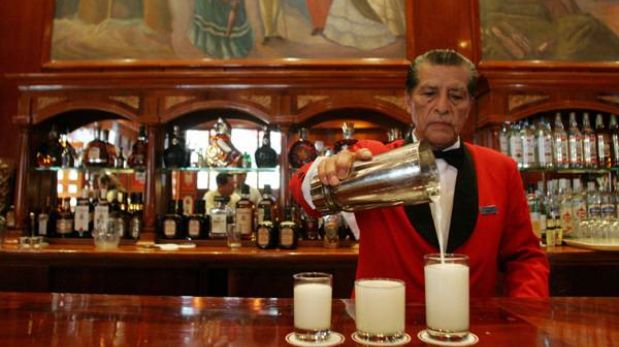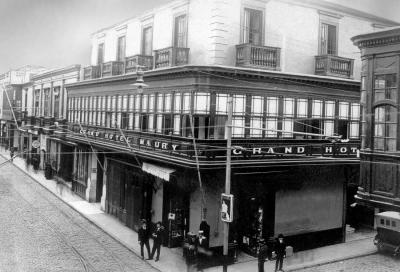As I write today
temperatures are moving on up into the 30s here in Lisbon. Time for one of my
all-time favourite summer cocktails - Chilcano de Pisco.
Pour a good large
measure of Pisco (about 50ml) over plenty of ice cubes in a tall glass, add a
squeeze of lime juice (about a tablespoon), a splash of Angostura bitters, and
top it all up with ginger ale. Have fun playing around with the measurements if
you like, but I have it on good authority that it’s all in the order of
ingredients in the glass.
 |
| photo - El Comercio |
Pisco Sour is the better
known classic Peruvian cocktail, and some years ago I went to the bar at the Hotel Maury to research the lineage of this most cherished lovechild of Peruvian culture.
If I’m honest it was a chance to just hang out in this coolest of cool bars in the heart of downtown Lima on a dusty Sunday afternoon. But I was also lucky enough to watch a master at work. Señor Eloy Cuadros Cordoba has worked at the Hotel Maury for more than half a century. The full interview, complete with Señor Cuadros' tips for the perfect Pisco Sour, is here.
If I’m honest it was a chance to just hang out in this coolest of cool bars in the heart of downtown Lima on a dusty Sunday afternoon. But I was also lucky enough to watch a master at work. Señor Eloy Cuadros Cordoba has worked at the Hotel Maury for more than half a century. The full interview, complete with Señor Cuadros' tips for the perfect Pisco Sour, is here.
 |
| Señor Eloy Cuadros Cordoba doing what he does best behind the bar at the Maury photo - el Comercio |
 |
| fig. 1 |
The Posada de Pedro Maury existed since the days of independence. General San Martin himself stayed there, as well as Miguel Grau. Later the posada was refurbished and modernized and in 1848 became Lima's first great illustrious hotel - the Hotel Maury.
Today it is a rather prosaic 1954 version of the original. Needless to say it has lost much of its former grandeur, but the bar is still splendid and proclaims to be the birthplace of the Pisco Sour as we know it.
As Cuadros, the resident, charismatic barman will testify, his clientele is now a mixed bunch of professionals and tourists, although the Maury still sees the odd diplomat or two popping in from the Ministry of Foreign Affairs just up the road.
 |
| photo - citiHeartBeat |
Tio Hernan makes it clear that back in the day, the Maury had clout; home to a glittering array of politicians, business men, and the social elite.
Peru’s devastating loss to Chile in the War of the Pacific (1884), and the country’s ensuing bankruptcy spawned a group of young intellectuals who questioned what had happened, what had gone wrong, and more importantly addressed the issue of what needed to happen now. How was Peru to emerge and develop and move forward? They are known as la generación de los 900 (900 is short for 1900’s), and they were the emerging thinkers of the new twentieth century.
Victor Andrés Belaunde, Raul
Porras Barrenechea, José de la Rivera Agüero, Francisco Garcia Calderón -the
journalist, writer and diplomat who Hernan describes here returning to Peru
after his postings abroad. These are all
names that resonate in Peru still today.
They all gathered at the Maury
and they were, as Hernan points out here, all white.
Banquet at the Maury
In which Tello appears on the radar of Lima's society elite
If all the anecdotes from the Hotel Maury could be compiled, we would have a fascinating record of the many subtle nuances of our nation's story. So many of the men, in so many diverse fields, who helped trace the route of our country's history have passed through those doors
On this occasion, none other than, the
famous Peruvian philosopher and writer, Francisco Garcia Calderón had just
arrived in Lima from Paris, and his friends wanted to organize a banquet in his
honour. Naturally it would be in one of the city’s most luxurious and
prestigious locales … the Maury.
The event was to be hosted by Ricardo Palma, and he asked Tello, who had just left the National Library to set up his own medical practice, if he was coming. The budding scientist in fact had not planned to be there, most likely because the cost of the event was ten soles, and at that time ten soles was an amount he could scarcely afford. He did not yet have many patients and needed all the money he could find to cover other more pressing expenses. Nevertheless Ricardo Palma insinuated to him that if he could possibly make the effort to attend it would, in the long run, be to his advantage.
When Tello arrived at the banquet he found the grand rooms of the Maury full of the crème de la crème of Lima society; along with many of the city’s intelligentsia. It was not in Tello’s nature to be intimidated. But he did feel slightly uncomfortable finding himself thrown amongst the members of a society who worshipped at the altar of ‘lineage’. What could he expect from such people who were of such different background to his own, and when he himself existed solely on his own virtues of resolve, tenacity and talent?
However the great, generous spirited Don Ricardo Palma had a surprise for him. When it came to the speeches, he began by emphasizing the great reputation and achievements of Garcia Calderón. Then in the same breath he went on to elucidate upon the merits of that whole generation. It was important, he said, to acknowledge the outstanding ability of three people in particular. Two of these were sons of former presidents. One was Garcia Calderón, the other was the political philosopher, José de la Rivera Agüero. The other was Julio C Tello.
This last name met with
silence. It belonged to no one either well connected or well known, but Palma
went on to describe him as a young scientist with a brilliant future. The
society crowd was curious, and for some of them this curiosity was doubtless
tinged with a certain amount of disapproval. Here was a young man who was not
one of them. His complexion was not quite right. There was no mistaking the
definite features and colour of an Indian.
The
impression these words were to have on the young Tello was ineffable. When he
arrived back at his humble lodgings he sat down and wept; wept tenderly for the
long tenacious battle he had fought and won against poverty and disadvantage.
His father, who had always had so much faith in the triumph of his son, had
died some years previously, without seeing his efforts come to fruition. Those three men mentioned at the banquet
achieved great reputations. I only
wonder if the other two reached quite the heights of the low born Tello, who in
his own way and in the opinion of his colleagues throughout the world, was
acknowledged as a colossus in his own sphere.
fig 1: taken from Una Lima que se fue
fig 2: Dining room at the old Maury Hotel (skyscrapercity.com)
taken from Rumbo al Bicentenario - blog de Juan Luis Orrego Penagos
fig 3: The old Maury Hotel
as above
fig 1: taken from Una Lima que se fue
fig 2: Dining room at the old Maury Hotel (skyscrapercity.com)
taken from Rumbo al Bicentenario - blog de Juan Luis Orrego Penagos
fig 3: The old Maury Hotel
as above


No comments :
Post a Comment